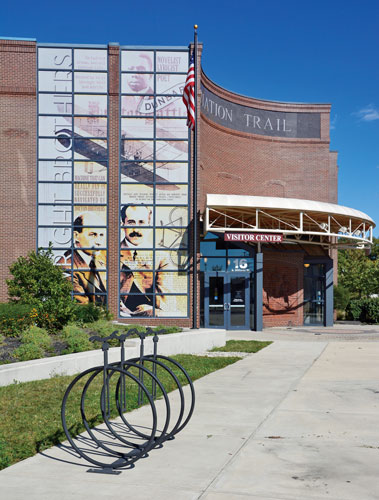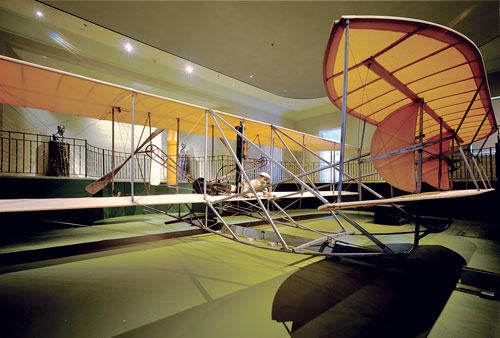By Eric Spangler
 On a bluff overlooking the Mad River valley a short drive from downtown Dayton is a view that encompasses both the past and the future of man’s dream to fly.
On a bluff overlooking the Mad River valley a short drive from downtown Dayton is a view that encompasses both the past and the future of man’s dream to fly.
Looking northeast one can see a small, white flag waving at the end of an empty field and beyond that stretch long, asphalt runways. The white flag designates Huffman Prairie, the former cow pasture where Wilbur and Orville Wright perfected their airplane, while the runways of Wright-Patterson Air Force Base signify the technological future of aviation.
The hillside bluff overlooking the two sites is part of the Huffman Prairie Flying Field Interpretive Center, just one of the spots aviation enthusiasts and fans of history can visit in the National Aviation Heritage Area.
The National Aviation Heritage Area, created in 2004 by Congress, encompasses more than a dozen aviation-related sites and attractions throughout an eight-county area in Ohio, including Montgomery, Greene, Miami, Clark, Warren, Champaign, Shelby and Auglaize counties.
The National Aviation Heritage Area is one of 49 National Heritage Areas in a program administered by the National Park Service. The National Aviation Heritage Area essentially got its start when Aviation Trail Inc. was formed as a nonprofit corporation in 1981. The organization’s goal is to promote Dayton’s aviation heritage that began in 1903 when the Wright brothers invented the airplane.
During the organization’s research to develop a brochure for self-guided tours of the aviation-related sites and attractions, two little-known buildings with connections to the Wright brothers were uncovered on Dayton’s west side. The group’s mission quickly expanded to include preservation.
Today those renovated buildings house the Wright-Dunbar Interpretive Center and Aviation Trail Visitor Center, the Aviation Trail Parachute Museum and The Wright Cycle Co. Those buildings are a great place to start a visit to the National Aviation Heritage Area because they’re located within steps of each other and all are free.
The glue that connects all of the aviation-related sites within the National Aviation Heritage Area is the National Aviation Heritage Alliance, a private, not-for-profit corporation, says Tim Gaffney, the alliance’s director of communications.
Gaffney says the National Aviation Heritage Alliance was designated by Congress as the management group of the National Aviation Heritage Area. Its mission is to foster collaboration amongst the partner organizations, he says.
One of those partner organizations and aviation-related sites is the National Museum of the United States Air Force. The museum, located at Wright-Patterson Air Force Base, is the world’s largest and oldest military aviation museum. The museum draws about 1 million visitors from around the world every year, says Rob Bardua, public affairs specialist with the National Museum of the U.S. Air Force.
The museum has more than 360 aerospace vehicles on display, including the Sam 2600 aircraft—known as Air Force One—that transported President John F. Kennedy to Dallas and then was later used to swear in Lyndon Johnson as president on his flight back to Washington D.C.
That aircraft, formerly housed in a secure area on the Air Force base that required visitors to board a bus to view, will soon be featured in the Presidential Gallery in a new 224,000-square-foot building that will open in June, says Bardua.
Another important aircraft that will be housed in the Research and Development Gallery in the new building is the XB70 Valkerie, a high-altitude bomber that could fly three times the speed of sound. Only two were ever built and the one at the museum is now the only one remaining in the world, says Bardua.
Visitors to the National Museum of the U.S. Air Force can also get a behind-the-scenes glimpse of the restoration of one of the most famous World  War II aircraft, the B-17 Memphis Belle, he says.
War II aircraft, the B-17 Memphis Belle, he says.
“Some people spend two to three days here because there’s so much and they want to see everything,” says Bardua.
Another aviation-related site with plenty to see is the John W. Berry Sr. Wright Brothers Aviation Center at Carillon Historic Park. Inside the aviation center is the original 1905 Wright Flyer III, the world’s first practical airplane capable of repeated and controlled flight, says Alex Heckman, director of education and museum operations.
How significant is that aircraft? “It’s the only airplane that’s ever been designated a national historic landmark,” says Heckman. Orville Wright helped put the airplane together. “The restoration of that plane was the world’s first pilot’s last project,” he says.
Not only does the Wright Brothers Aviation Center house the Wright Flyer III, it is also home to the most three-dimensional Wright artifacts in the world, says Bardua. Some of those artifacts includes the Wright brothers’ mother’s sewing machine that they used to sew fabric on the wings of their aircraft, the Wright brothers’ camera that was used to take the famous photo of their first successful airplane flight, two of the five original Wright brothers bicycles left in the world, and the family Bible.
Dayton History, which operates Carillon Park, also conducts tours of the Wrights’ former home, Hawthorn Hill, a national historic landmark home, says Heckman.
For those who are more interested in seeing an aircraft that looks similar to a Wright brothers’ plane—and one that actually flies—then the Wright B Flyer Inc. is the place to visit.
The all-volunteer organization, located at the Dayton-Wright Brothers Airport, promotes Dayton’s aviation heritage by flying and displaying lookalikes of the Wright Model B airplane.
The organization’s flying lookalike, called “Brown Bird,” is about to get a companion in its hanger. The group is currently building another airplane to succeed “Brown Bird,” says Jay Jabour, president of the Wright B Flyer Inc.
The group has recruited volunteers in the experimental aircraft community to help build some of the parts and Jabour says they hope to have the final assembly of the aircraft in the original Wright B Flyer factory. “The historic part of building a Wright B Flyer in the original Wright B Flyer factory is really interesting for us,” says Jabour.
